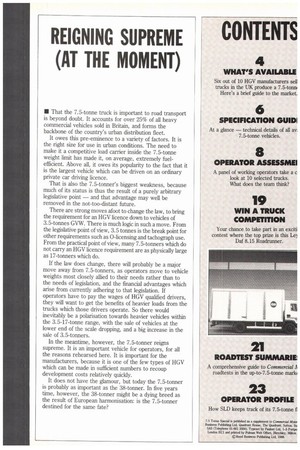REIGNING SUPREME (AT THE MOMENT)
Page 45

If you've noticed an error in this article please click here to report it so we can fix it.
II That the 7.5-tonne truck is important to road transport is beyond doubt. It accounts for over 25% of all heavy commercial vehicles sold in Britain, and forms the backbone of the country's urban distribution fleet.
It owes this pre-eminence to a variety of factors. It is the right size for use in urban conditions. The need to make it a competitive load carrier inside the 7.5-tonne weight limit has made it, on average, extremely fuelefficient. Above all, it owes its popularity to the fact that it is the largest vehicle which can be driven on an ordinary private car driving licence.
That is also the 7.5-tonner's biggest weakness, because much of its status is thus the result of a purely arbitrary legislative point — and that advantage may well be removed in the not-too-distant future.
There are strong moves afoot to change the law, to bring the requirement for an HGV licence down to vehicles of 3.5-tonnes GVW. There is much logic in such a move. From the legislative point of view, 3.5 tonnes is the break point for other requirements such as 0-licensing and tachograph use. From the practical point of view, many 7.5-tonners which do not carry an HGV licence requirement are as physically large as 17-tonners which do.
If the law does change, there will probably be a major move away from 7.5-tonners, as operators move to vehicle weights most closely allied to their needs rather than to the needs of legislation, and the financial advantages which arise from currently adhering to that legislation. If operators have to pay the wages of HGV qualified drivers, they will want to get the benefits of heavier loads from the trucks which those drivers operate. So there would inevitably be a polarisation towards heavier vehicles within the 3.5-17-tonne range, with the sale of vehicles at the lower end of the scale dropping, and a big increase in the sale of 3.5-tonners.
In the meantime, however, the 7.5-tonner reigns supreme. It is an important vehicle for operators, for all the reasons rehearsed here. It is important for the manufacturers, because it is one of the few types of HGV which can be made in sufficient numbers to recoup development costs relatively quickly.
It does not have the glamour, but today the 7.5-tonner is probably as important as the 38-tonner. In five years time, however, the 38-tonner might be a dying breed as the result of European harmonisation: is the 7.5-tonner destined for the same fate?
















































































































